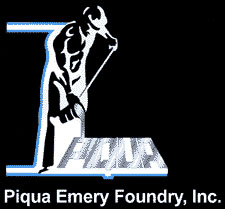UNDERSTANDING CASTNGS
Aluminum, Bronze & Zinc
Making the Pattern
To make quality castings, a foundry must have quality patterns. A basic pattern, called a “loose pattern,” can be used for a very small quantity of production pieces, however the quality may suffer. Mounting the “loose pattern” on a board to fit a certain flask makes the job easier and can improve the quality somewhat, but, again, it is only for short runs in production. Wood or epoxy patterns are used for medium production. These patterns are mounted on a “Follow Board,” which is a board made to follow the contours of the pattern. For long runs and top quality, the pattern is made into an aluminum matchplate, usually with half the pattern on each side of the matchplate. These patterns maintain their durability and withstand the usage that the large production runs give them.
Fast Turnaround
To make this mold, the top (Cope) half of the flask is removed from the bottom (Drag) half. The matchplate (with half of the pattern on each side) is inserted between the Cope and Drag. The flask is then placed on the “Squeezer” with the Drag half in the upward position. The Drag is filled with sand, then rammed and jolted until the sand is settled. A board is placed over the top of the Drag and the mold is completely rolled over so the Cope half is facing upward. The Cope half is filled with sand, then rammed and squeezed. Once the pouring hole, or “Sprue,” is cut into the sand, the Cope is lifted off the Drag and the pattern is removed, leaving the mold ready for pouring.
The Metal…properties and applications
The casting of pure aluminum isn’t feasible as it presents many problems in the foundry. Other elements are therefore added to improve properties and castability. The elements most alloyed with aluminum are copper, silican, magnesium, and to a lesser extent, manganese, iron, zinc, and nickle. The effect of the added elements is to increase fluidity, machinability, strength, and hardness. Our most popular alloy, #319 aluminum, is an all-purpose metal. We filter and degas this metal until we get “aircraft” quality. We have Almag 35, A-356.2, 355, 356, and #713 and ZA12 zinc. In copper alloys, we have 85-5-5-5, 81-3-7-9, 80-10-10, and 415-9-C Aluminum Bronze.
Pouring the Metal
The melting, the degassing, and the POURING of the metal have a great deal to do with quality castings. Our employee’s take great care with all metals, and we take vacuum tests constantly throughout each work day to test for gas in the melt. When gas is found, corrections are made immediately. Many intricate castings take special care in pouring, as some must be poured very hard, while others a gentle, smooth flow of metal through the mold produces the best casting. These things are only garnered through experience, and being here since 1920 has provided us with the needed expertise.
The Finishing Process
In obtaining the right finish for any casting, one should first consider the ascast smoothness of the casting, then the mechanical finish, and finally the finish to be applied to the surface of the casting. Most aluminum castings from the foundry have a good finish without further treatment, however we do have in-house wire brushing, tumble blast machines, plus many chipping and grinding tools. Out of house treatment (alodining, painting, etc.) can be provided, along with complete machining of the product. For fan props, we can also furnish complete balancing along with machining, boring, set screw, etc., so props can be placed on a motor shaft without any problems.

